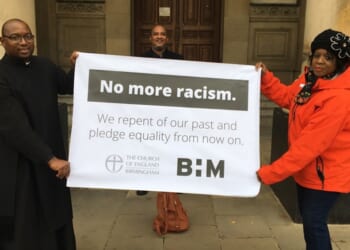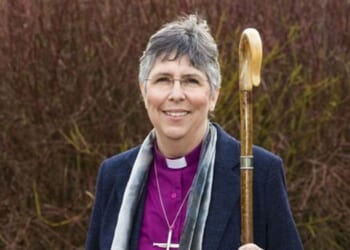DESPITE polling heralded as revealing a “quiet revival”, the Church of England is — by almost every measure and in almost every diocese — smaller than it was in 2018, this year’s Statistics for Mission show.
The data, published on Tuesday, record that in 2024 attendance rose for the fourth year, but that recovery since the Covid-19 pandemic has slowed. Increases in attendance since 2023 were smaller than in previous years. In 2019, a “middle-sized” church had an all-age average weekly attendance (AWA) of 34.5; in 2024, the equivalent figure was 26. The median church has just one child in attendance, compared with three in 2019.
Adult AWA (based on in-person attendance in October) was 18 per cent lower than in 2019, and 1.8 per cent higher than in 2023. This was five per cent below the projected pre-pandemic trend.
Child AWA was 24 per cent lower than in 2019 (one per cent below the projected trend) and 0.4 per cent higher than in 2023. The total worshipping community (the number estimated to attend at least monthly) was 9.4 per cent lower than in 2019, and 0.6 per cent higher than in 2023. This constitutes 1.7 per cent of the population of England.
The Bible Society report The Quiet Revival, published in April, drew on YouGov polls conducted in 2018 and 2024 with 19,101 and 13,146 adults respectively (News, 11 April). The results suggested that church attendance in England and Wales had risen by a half from 2018 to 2024, and that C of E attendance had risen by a quarter.
Dr Ken Eames, the Church of England’s senior statistical research officer, addresses this apparent discrepancy. “As the Statistics for Mission figures clearly demonstrate, by almost every measure, in almost every diocese, Church of England attendance and participation was still significantly lower in 2024 than in 2018,” he writes in this week’s report.
”It would be naïve to believe that the Statistics for Mission figures are accurate to the nearest person; however, I am confident that the national totals and trends calculated from the Statistics for Mission dataset are broadly accurate. I base that confidence on the high response rate, consistent methodology applied year on year, detailed church-by-church data checking, and consistency of results across variables and across dioceses.”
There is “not always a clear trend when looking at an individual church”, he writes. “Nevertheless, however one chooses to look at it, more Church of England churches became smaller from 2019 to 2024 than grew.”
For one in ten churches (12 per cent), the usual Sunday attendance, average Sunday attendance, and AWA were all higher in 2024 than in 2019. But in almost half (48 per cent), the numbers were lower across all measures.
Dr Eames notes in the report that most measures of attendance and participation had been showing a gradual decline over many decades until 2019. “It is impossible to say what would have happened if there had not been a pandemic, but it is reasonable to assume that the decline would have continued,” he writes. “We would therefore not expect numbers to return to their 2019 values, even once all pandemic effects are over.”
Some measures remained below projected pre-pandemic trends, while others are approaching or above projected trends. Baptisms and marriages in 2024 were approximately 30 per cent fewer than in 2019, and approximately ten per cent fewer than in 2023. Infant baptisms (aged below one) fell by almost a half to 26,900 between 2019 and 2024. Adult baptisms, however, increased from 7400 to 8700.
Dr Eames writes: “Despite the substantial recovery in baptism numbers, there are in the region of 40,000 people not yet baptised who would have been baptised had there not been a pandemic.”
C of E funerals were 24 per cent fewer than in 2019, and ten per cent fewer than in 2023. But the proportion of funerals in churches rather than in crematoria and cemeteries now exceeds pre-pandemic levels: 68 per cent compared with 62 per cent.
The data suggest that the age distribution of worshipping communities has changed since 2019. Overall, 35 per cent were over-70s, compared with 33.3 per cent in 2019 and 13.5 per cent in the population as a whole.
While child attendance in 2024 was close to or above the projected pre-pandemic trend, this reflects the previous steep decline in this measure. One third of churches had an AWA of no under-16s in 2024, compared with one quarter of churches in 2019. In 2024, 32 per cent of churches had no children in their worshipping community, compared with 26 per cent of churches in 2019. Churches’ ministry teams were also less likely to have led acts of worship in schools in 2024 than in 2019.
A minority — 14 per cent — of churches reported having one or more paid leaders of ministry with children and young people. Forty-four per cent reported having one or more unpaid leaders.
The data suggest that children’s attendance now tends to be concentrated in the largest churches. In 2024, the ten per cent of churches with the largest child AWA contributed 59 per cent of all child AWA, compared with 53 per cent in 2019. In this period, the number of churches with an AWA of 25 or more under-16s fell from 1270 to 850.
Slightly less than five per cent of the members of worshipping communities in 2024 were people who were entirely or predominantly “Church at Home” worshippers, compared with ten per cent in 2021. Seventeen per cent of churches reported some attendance at in-person fresh expressions, compared with 21 per cent in 2019.
In total, 1300 new congregations or new worshipping communities were reported as having been started in 2024, while 570 congregations/worshipping communities came to an end.
A breakdown of the data by diocese indicates a high level of variation. On average, the worshipping community fell by nine per cent. But, while Canterbury and Derby reported a decline of 19 per cent and Salisbury a decline of 22 per cent between 2019 and 2024, Bristol recorded a fall of just 0.5 per cent, and London and Worcester both reported slightly higher numbers than before.
London’s AWA fell by 17 per cent in that period, and Worcester’s by 40 per cent. Liverpool reported that its worshipping community had exceeded 2019 figures in 2023, followed by a slight dip in 2024, but its AWA has fallen by 21 per cent since 2019.
The data also suggest wide variations in age profile, partly reflecting broader geographical demographics. In both Bath & Wells and Truro, more than half the worshipping community are over-70s; in Hereford, the figure is 48 per cent. Much higher proportions of under-18s are reported in urban areas, including Southwark and Manchester (both more than one quarter).

















